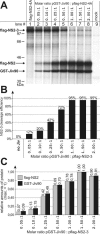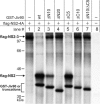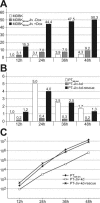Persistence of bovine viral diarrhea virus is determined by a cellular cofactor of a viral autoprotease
- PMID: 16014936
- PMCID: PMC1181585
- DOI: 10.1128/JVI.79.15.9746-9755.2005
Persistence of bovine viral diarrhea virus is determined by a cellular cofactor of a viral autoprotease
Abstract
Polyprotein processing control is a crucial step in the life cycle of positive-strand RNA viruses. Recently, a vital autoprotease generating an essential viral replication factor was identified in such a virus, namely, the pestivirus bovine viral diarrhea virus. Surprisingly, the activity of this protease, which resides in nonstructural protein 2 (NS2), diminishes early after infection, resulting in the limitation of viral RNA replication. Here, we describe that a cellular chaperone termed Jiv (J-domain protein interacting with viral protein) acts as a cofactor of the NS2 protease. Consumption of the intracellular Jiv pool is responsible for temporal regulation of protease activity: overexpression of Jiv interfered with regulation and correlated with increased accumulation of viral RNA; downregulation of the cellular Jiv level accelerated the decline of protease activity and reduced intracellular viral RNA levels and virion production. Accordingly, the amount of a cellular protein controls pestiviral replication by limiting the generation of active viral protease molecules and replication complexes. Importantly, this unique mechanism of replication control is essential for maintenance of the noncytopathogenic phenotype of the virus and thereby for its ability to establish persistent infections. These results add an entirely novel aspect to the understanding of the molecular basis of viral persistence.
Figures







Similar articles
-
A cellular J-domain protein modulates polyprotein processing and cytopathogenicity of a pestivirus.J Virol. 2001 Oct;75(19):9470-82. doi: 10.1128/JVI.75.19.9470-9482.2001. J Virol. 2001. PMID: 11533209 Free PMC article.
-
Temporal modulation of an autoprotease is crucial for replication and pathogenicity of an RNA virus.J Virol. 2004 Oct;78(19):10765-75. doi: 10.1128/JVI.78.19.10765-10775.2004. J Virol. 2004. PMID: 15367643 Free PMC article.
-
CRISPR/Cas9-Mediated Knockout of DNAJC14 Verifies This Chaperone as a Pivotal Host Factor for RNA Replication of Pestiviruses.J Virol. 2019 Feb 19;93(5):e01714-18. doi: 10.1128/JVI.01714-18. Print 2019 Mar 1. J Virol. 2019. PMID: 30518653 Free PMC article.
-
Dissection of a viral autoprotease elucidates a function of a cellular chaperone in proteolysis.Proc Natl Acad Sci U S A. 2006 Jan 31;103(5):1510-5. doi: 10.1073/pnas.0508247103. Epub 2006 Jan 23. Proc Natl Acad Sci U S A. 2006. PMID: 16432213 Free PMC article.
-
RNA recombination in pestiviruses: cellular RNA sequences in viral genomes highlight the role of host factors for viral persistence and lethal disease.RNA Biol. 2011 Mar-Apr;8(2):216-24. doi: 10.4161/rna.8.2.14514. Epub 2011 Mar 1. RNA Biol. 2011. PMID: 21358277 Review.
Cited by
-
Pestivirus virion morphogenesis in the absence of uncleaved nonstructural protein 2-3.J Virol. 2012 Jan;86(1):427-37. doi: 10.1128/JVI.06133-11. Epub 2011 Oct 26. J Virol. 2012. PMID: 22031952 Free PMC article.
-
Bovine viral diarrhea virus: prevention of persistent fetal infection by a combination of two mutations affecting Erns RNase and Npro protease.J Virol. 2007 Apr;81(7):3327-38. doi: 10.1128/JVI.02372-06. Epub 2007 Jan 10. J Virol. 2007. PMID: 17215285 Free PMC article.
-
The zymogenic form of SARS-CoV-2 main protease: A discrete target for drug discovery.J Biol Chem. 2025 Jan;301(1):108079. doi: 10.1016/j.jbc.2024.108079. Epub 2024 Dec 14. J Biol Chem. 2025. PMID: 39675720 Free PMC article.
-
Selection of classical swine fever virus with enhanced pathogenicity reveals synergistic virulence determinants in E2 and NS4B.J Virol. 2012 Aug;86(16):8602-13. doi: 10.1128/JVI.00551-12. Epub 2012 Jun 6. J Virol. 2012. PMID: 22674973 Free PMC article.
-
Cytopathic bovine viral diarrhea viruses (BVDV): emerging pestiviruses doomed to extinction.Vet Res. 2010 Nov-Dec;41(6):44. doi: 10.1051/vetres/2010016. Epub 2010 Mar 4. Vet Res. 2010. PMID: 20197026 Free PMC article. Review.
References
-
- Beck, J., and M. Nassal. 2003. Efficient Hsp90-independent in vitro activation by Hsc70 and Hsp40 of duck hepatitis B virus reverse transcriptase, an assumed Hsp90 client protein. J. Biol. Chem. 278:36128-36138. - PubMed
-
- Bridge, A. J., S. Pebernard, A. Ducraux, A. L. Nicoulaz, and R. Iggo. 2003. Induction of an interferon response by RNAi vectors in mammalian cells. Nat. Genet. 34:263-264. - PubMed
-
- Brummelkamp, T. R., R. Bernards, and R. Agami. 2002. A system for stable expression of short interfering RNAs in mammalian cells. Science 296:550-553. - PubMed
Publication types
MeSH terms
Substances
LinkOut - more resources
Full Text Sources

